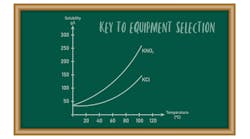Once solids are crystallized in the form of a wet cake, we normally would dry that cake. However, this step can alter the finished product in detrimental ways such as phase changes, lumpy material or solids that are much finer than intended. To prevent such issues, the first thing we need to evaluate is the particle strength — at least if we want to retain the particle size we spent so much time producing.
An alternative approach to drying may be to select and run the dryer so the particles enlarge; this saves time in the crystallization step. At one point, we had developed a new detergent that avoided some major environmental issues. The chemists had laid out the crystallizer to make particles in the 300-µ range. While these particles were easily separated from the mother liquor, they were fragile; the most economical dryers produced too many fine particles, which would create a dust problem for the consumer. The solution was to make 50-µ particles in the crystallizer and run the fluid bed as an agglomerator. The crystallization time was very short, and the fluid bed produced a stronger particle. Also, we could mix fines from the dryer with the wet cake.
The conventional route for producing particulate solids is:
1. crystallize;
2. filter or centrifuge the solids along with a washing step; and
3. dry to the final solvent content.
Another option is to crystallize the solids, follow with a liquid separation step, and then redissolve the solids before a second crystallization. Often, the product can be spray-dried to the final material. Many precipitations are processed in a similar manner. Sometimes, the better route is to change the crystallization endpoint, as described above, to get the desired particle strength or some other characteristic.
As I emphasized in my July 2018 column (“Develop Drying Curves”), a drying curve is very important. I’m not talking about a test at one temperature but instead running a series of temperatures and humidities. Remember, the primary determinant of drying rate is the difference between the partial pressure of solvent in the gas that surrounds the particle and the partial pressure of the solvent at the surface of the solid. One way to improve the quality of the drying curve is to measure the single-particle drying characteristics, as described in the 2018 column. Using that technique, you can design most dryers without doing the test in each type of dryer (i.e., spray, fluid bed, drum, rotary, flash, etc.) to assess the feasibility of your selection. Then, you can focus your attention on the details of the dryer design and how it integrates into your overall process design.
Now armed with a good drying curve and data on particle strength, what else should you consider? Most people start their dryer selection by asking about the wet cake characteristics. I always start a process design by asking the question, “What do you want the final product to look like?” After all, the most important part of a process design is making final product with the desired characteristics.
Each dryer has strengths and weaknesses. Starting from the wet cake side of the process will emphasize the feeding of material, rather than discharge and downstream handling of the product. For example, a drum dryer does a nice job of removing very low amounts of solvent; however, perhaps it will have to deal with clumps that may have pockets of wet product. Maybe a belt dryer would give a more uniform product.
While hundreds of dryer designs exist, I only can focus on a small subset in this column. So, we’ll concentrate on the workhorses — fluid beds, spray dryers and rotary dryers. I picked these because they behave quite differently and have unique advantages and disadvantages. They all rely on dispersion and highly depend on convective heating. We find them primarily in continuous processes but they sometimes do appear in batch operations. Fluid beds can be heated in the dryer by direct contact with an internal heat exchanger or by heating the gas. Internal heating is especially useful for heat-sensitive materials. Rotary dryers can handle slurries or sticky solids better than most fluid beds; spray dryers will take on high solvent concentration feeds. Also, as we’ll see in the next column, they all require gas cleaning systems.


